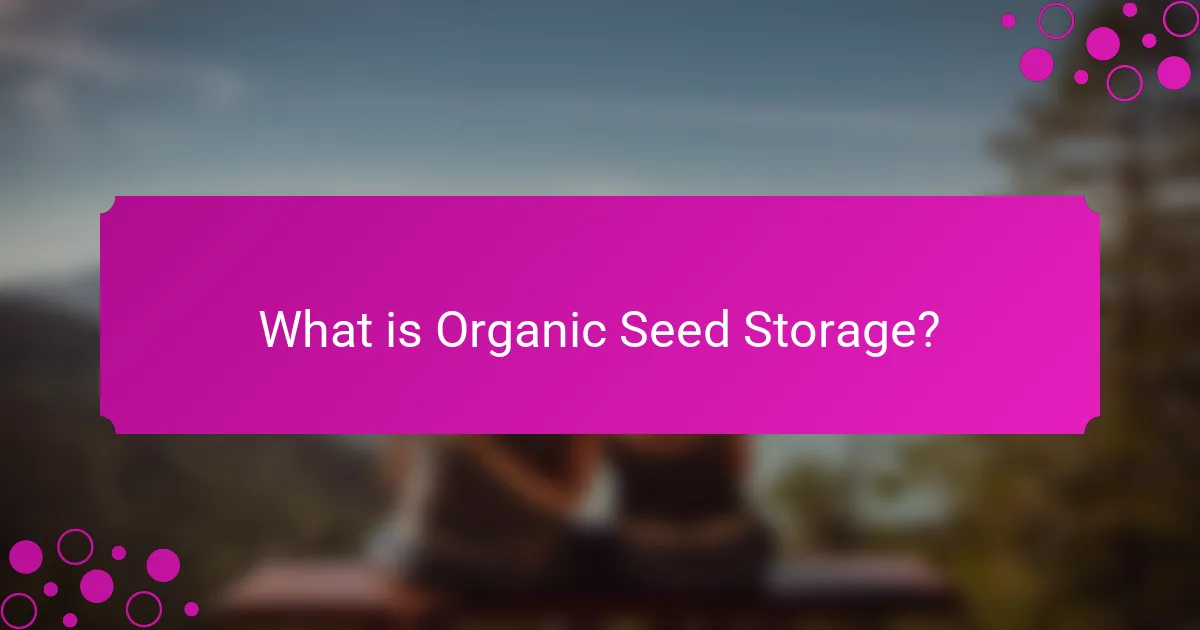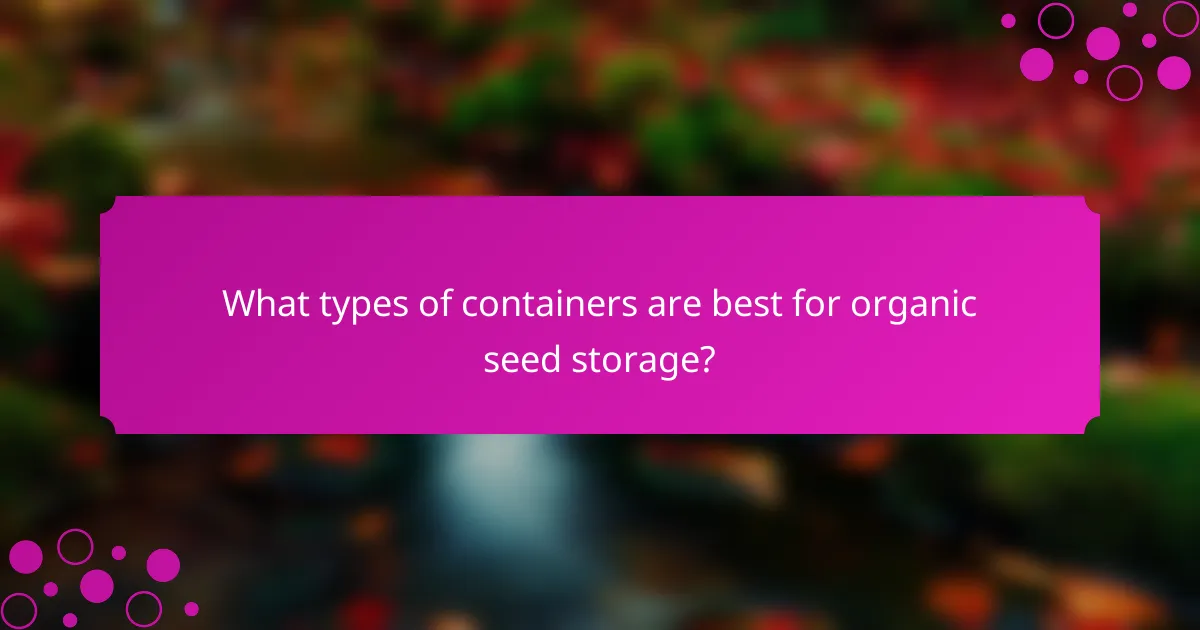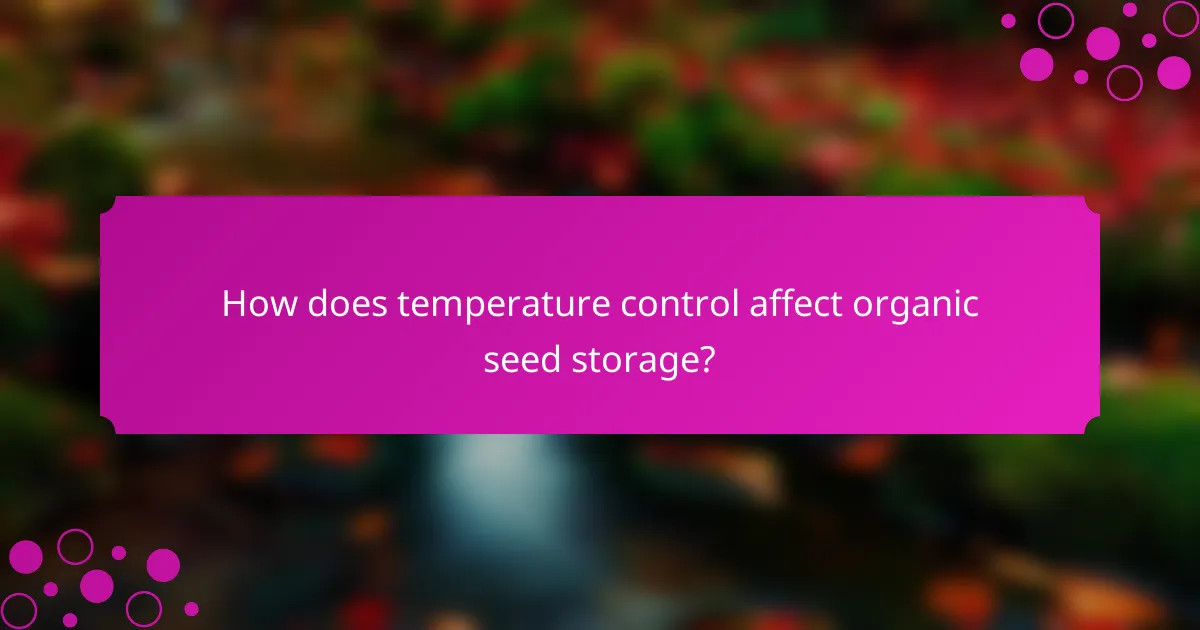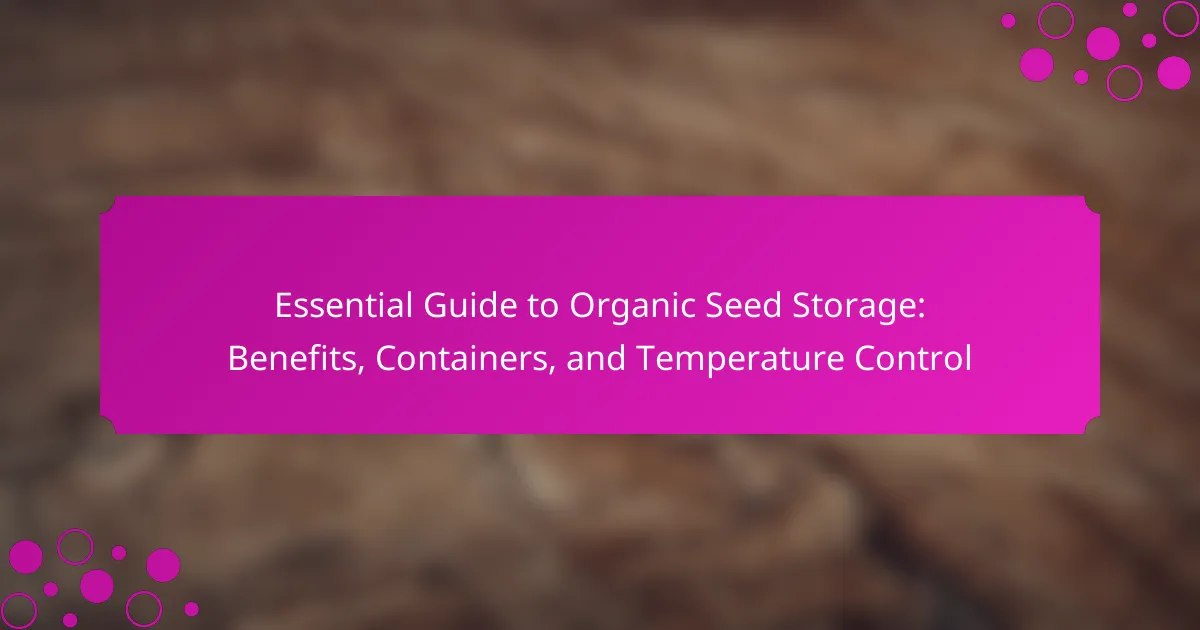Organic seed storage is the practice of preserving seeds from organic plants to maintain their viability and genetic integrity for future planting. This article outlines the essential aspects of organic seed storage, including the importance of controlling temperature, humidity, and light exposure to enhance seed longevity and germination rates. It highlights the best containers for storage, such as glass jars and metal containers, and emphasizes the significance of labeling for easy identification. Furthermore, the article details the optimal temperature range for seed storage, explaining how effective temperature management can significantly extend seed life and preserve quality.

What is Organic Seed Storage?
Organic seed storage is the practice of preserving seeds from organic plants in a way that maintains their viability and genetic integrity. This method ensures that seeds remain healthy for future planting. Proper organic seed storage involves controlling temperature, humidity, and light exposure. These factors significantly influence seed longevity and germination rates. For example, seeds stored in cool, dark conditions can last for several years. Additionally, using breathable containers helps prevent moisture buildup. This practice is essential for sustainable agriculture and biodiversity conservation.
Why is proper seed storage important for gardeners?
Proper seed storage is crucial for gardeners to maintain seed viability and ensure successful planting. Seeds require specific conditions to remain dormant yet viable. Proper storage prevents moisture, pests, and temperature fluctuations that can damage seeds. For example, seeds stored in cool, dry, and dark environments can last for several years. According to the USDA, some seeds can lose viability within a year if not stored correctly. Maintaining optimal conditions prolongs the lifespan of seeds and enhances germination rates. This practice ultimately leads to healthier plants and more productive gardens.
What factors contribute to seed viability over time?
Seed viability over time is influenced by several factors. Moisture levels are critical; seeds stored in dry conditions have higher viability. Temperature also plays a significant role; cooler temperatures generally enhance longevity. Light exposure can degrade seeds; thus, dark storage is preferable. Oxygen levels affect seed respiration; low oxygen environments can prolong viability. Seed age is another factor; older seeds tend to have reduced viability. Proper storage containers can protect seeds from pests and environmental factors, further maintaining viability. These factors collectively determine how long seeds can remain viable for germination.
How does seed storage impact plant health and growth?
Seed storage significantly impacts plant health and growth by preserving seed viability and preventing deterioration. Proper storage conditions, such as low humidity and cool temperatures, can extend seed lifespan. Seeds stored in optimal conditions can maintain higher germination rates. Research shows that seeds stored at 5°C and 20% relative humidity retain viability for several years. Conversely, seeds exposed to high moisture or temperature can lose viability quickly. For example, a study published in the Journal of Seed Technology demonstrated that seeds stored improperly germinated at only 50% compared to 90% for well-stored seeds. Thus, effective seed storage is crucial for successful planting and crop yield.
What are the benefits of organic seed storage?
Organic seed storage preserves seed viability and genetic diversity. It prevents seed deterioration caused by environmental factors. Proper storage conditions maintain seed health over time. This practice allows for the cultivation of heirloom and rare varieties. It supports sustainable agricultural practices by reducing the need for commercial seeds. Organic seed storage also promotes biodiversity in ecosystems. Studies show that properly stored seeds can remain viable for years. This contributes to food security and resilience against climate change.
How does organic seed storage promote biodiversity?
Organic seed storage promotes biodiversity by preserving a wide variety of plant genetic material. This practice allows for the conservation of heirloom and native plant varieties. These varieties are crucial for maintaining ecosystem resilience. They provide essential traits like disease resistance and adaptability to changing climates. By storing seeds, farmers and conservationists safeguard against loss of genetic diversity. This is important as monoculture practices can lead to vulnerabilities in food systems. Research indicates that diverse plant populations can enhance agricultural productivity. Therefore, organic seed storage plays a vital role in sustaining biodiversity.
What advantages does it offer for sustainable gardening practices?
Organic seed storage offers multiple advantages for sustainable gardening practices. It preserves seed viability, ensuring that seeds remain healthy and capable of germination. Proper storage prevents seed degradation caused by moisture, light, and temperature fluctuations. This practice promotes biodiversity by allowing gardeners to save and share seeds from heirloom and native plants. It reduces the need for purchasing new seeds, thus lowering costs and minimizing environmental impact. Additionally, organic seed storage supports local ecosystems by encouraging the cultivation of regionally adapted plants. Studies indicate that seed saving can enhance resilience against pests and diseases, contributing to sustainable gardening efforts.

What types of containers are best for organic seed storage?
Glass jars are the best containers for organic seed storage. They provide an airtight seal that protects seeds from moisture and pests. Metal containers also work well, offering durability and protection from light. Plastic containers can be used, but they must be opaque to prevent light exposure. Vacuum-sealed bags are effective for long-term storage, minimizing air exposure. It is essential to label containers with seed type and date for easy identification. Proper storage conditions help maintain seed viability for future planting.
How do different materials affect seed storage?
Different materials significantly affect seed storage by influencing moisture retention, temperature regulation, and pest protection. For instance, glass containers provide airtight seals that prevent moisture ingress. This helps maintain seed viability over extended periods. Plastic bags, while lightweight, may allow some air exchange, which can lead to moisture accumulation. Metal containers offer durability and protection against pests but can conduct heat, potentially raising internal temperatures. Paper bags are breathable but may not protect against humidity. Each material’s properties determine how well seeds are preserved. Studies show that optimal storage conditions can extend seed longevity by up to 50%.
What are the pros and cons of glass containers?
Glass containers have several pros and cons.
Pros include their ability to be non-toxic and environmentally friendly. Glass does not leach chemicals into contents. It is also impermeable to gases and moisture, which helps preserve food quality. Glass containers are durable and can be reused multiple times. They are also aesthetically pleasing and can be used for storage or display.
Cons include their potential for breakage. Glass containers can shatter if dropped or mishandled. They are generally heavier than plastic alternatives, which can make transport more cumbersome. Glass containers can also be more expensive compared to plastic options. Additionally, they may not be suitable for all types of storage, especially in environments where weight and fragility are concerns.
Why are breathable bags preferable for certain seeds?
Breathable bags are preferable for certain seeds because they allow air circulation while preventing moisture buildup. This circulation helps to maintain optimal humidity levels. Proper humidity is crucial for seed viability and longevity. Excess moisture can lead to mold growth and seed deterioration. Breathable materials, like cotton or burlap, facilitate this balance. They protect seeds from pests without trapping moisture. Studies show that seeds stored in breathable bags have higher germination rates. This makes them an effective choice for long-term seed storage.
What size and shape of containers should be used?
Containers for organic seed storage should be airtight and dark. The size should accommodate the quantity of seeds without excess space. Small containers are ideal for limited quantities. Larger containers suit bulk storage but must maintain airtight conditions. Shapes like jars or bins are effective for stability and organization. Using glass or high-quality plastic is recommended for durability. Research indicates that proper container choice can significantly extend seed viability.
How does container size influence seed preservation?
Container size significantly influences seed preservation by affecting air circulation and moisture retention. Smaller containers can lead to increased humidity levels, which may promote mold growth. Conversely, larger containers allow for better air flow, reducing moisture accumulation. Proper air circulation is crucial for maintaining seed viability over time.
Research indicates that seeds stored in appropriately sized containers can maintain higher germination rates. For instance, a study published in the Journal of Seed Technology found that seeds stored in larger, breathable containers showed a 20% higher germination rate after one year compared to those in smaller, sealed containers. This demonstrates the importance of selecting the right container size for optimal seed preservation.
What shapes are most effective for different seed types?
Different seed types are best stored in specific shapes to optimize preservation. Round seeds, such as peas, benefit from cylindrical containers. Cylindrical shapes allow for optimal air circulation and minimize moisture retention. Flat seeds, like lettuce, are best stored in shallow trays. Shallow trays prevent stacking, which can crush the seeds. Irregularly shaped seeds, such as beans, can be effectively stored in square or rectangular containers. Square shapes maximize space efficiency and organization. Research indicates that the shape of storage containers significantly influences seed longevity and viability. Proper shape selection enhances seed preservation and germination rates.

How does temperature control affect organic seed storage?
Temperature control significantly impacts organic seed storage by preserving seed viability and longevity. Optimal storage temperatures typically range from 32°F to 41°F (0°C to 5°C). At these temperatures, metabolic processes slow down, reducing seed deterioration. Conversely, higher temperatures can accelerate aging and decrease germination rates. For instance, seeds stored at 77°F (25°C) may lose viability much faster than those kept at cooler temperatures. Research indicates that maintaining lower temperatures can extend seed life by several years. Thus, effective temperature management is crucial for maintaining the quality of organic seeds.
What is the ideal temperature range for seed storage?
The ideal temperature range for seed storage is between 32°F and 41°F (0°C to 5°C). This temperature range helps maintain seed viability and prevents deterioration. Storing seeds at these temperatures slows down metabolic processes. It also reduces the risk of mold and pests. Research indicates that lower temperatures can extend seed longevity significantly. For example, seeds stored at 32°F can last much longer than those kept at room temperature. Proper temperature control is essential for effective seed preservation.
How can temperature fluctuations impact seed viability?
Temperature fluctuations can significantly impact seed viability. Seeds require specific temperature ranges for optimal germination and growth. Extreme temperature changes can cause stress, leading to reduced germination rates. For instance, temperatures that are too high can damage seed tissues. Conversely, excessively low temperatures can delay germination or cause seeds to become dormant. Research indicates that seeds stored at stable temperatures maintain higher viability than those exposed to variable conditions. A study by the International Seed Testing Association found that seeds stored at constant temperatures showed an average of 10% higher germination rates compared to those subjected to temperature fluctuations. Therefore, maintaining consistent temperatures is crucial for preserving seed viability.
What methods can be used to maintain consistent temperatures?
Methods to maintain consistent temperatures include using temperature-controlled storage units. These units can be set to specific temperature ranges ideal for seed preservation. Insulation also plays a vital role in temperature consistency. Proper insulation minimizes external temperature fluctuations. Additionally, using thermoregulators can help monitor and adjust temperatures automatically. Regularly checking temperature readings ensures that conditions remain stable. Finally, employing fans can improve air circulation, preventing hot or cold spots within storage areas.
Why is humidity control important in seed storage?
Humidity control is important in seed storage because it prevents seed deterioration. High humidity can lead to mold growth and seed decay. Seeds stored in moist conditions may also lose viability. Maintaining optimal humidity levels helps preserve seed quality. Research indicates that seeds stored at 20% humidity can remain viable for longer periods. Conversely, seeds exposed to higher humidity may germinate prematurely. Proper humidity control is essential for long-term seed storage success.
How does humidity affect seed germination rates?
Humidity significantly affects seed germination rates. High humidity levels can enhance germination by ensuring seeds absorb enough moisture. Conversely, excessively low humidity may lead to seed desiccation, inhibiting germination. Optimal humidity ranges vary by seed type but generally fall between 40% to 70%. Research indicates that seeds germinate best when moisture content reaches around 30% of their weight. Studies show that seeds exposed to adequate humidity can germinate faster and more uniformly. For instance, a study by Bewley and Black (1994) highlights the importance of moisture for activating enzymes necessary for germination. Thus, maintaining appropriate humidity is crucial for successful seed germination.
What tools can help monitor and control humidity levels?
Hygrometers and dehumidifiers are essential tools for monitoring and controlling humidity levels. Hygrometers measure the moisture content in the air, providing real-time data on humidity levels. Digital hygrometers offer precise readings and often include temperature measurements. Dehumidifiers remove excess moisture from the air, helping to maintain optimal humidity levels for seed storage. They come in various sizes, from small portable units to larger systems for extensive spaces. Additionally, humidistats can be integrated with dehumidifiers to automate humidity control. These tools are crucial for preserving the viability of organic seeds by preventing mold and decay.
What are some best practices for successful organic seed storage?
Store organic seeds in a cool, dry place to maintain viability. Ideal temperatures range from 32°F to 41°F (0°C to 5°C). Use airtight containers to protect seeds from moisture and pests. Glass jars or vacuum-sealed bags are effective options. Label containers with seed type and date of storage for easy identification. Check seeds periodically for signs of mold or pests. Maintain low humidity levels, ideally below 20%. Properly stored seeds can last several years, depending on the species.
How can labeling and organization improve seed storage efficiency?
Labeling and organization enhance seed storage efficiency by ensuring easy identification and access. Proper labeling allows for quick recognition of seed types, which reduces time spent searching for specific varieties. Organized storage prevents mix-ups between different seeds, maintaining genetic integrity. Efficient organization minimizes the risk of seed spoilage by ensuring optimal environmental conditions are maintained. Studies indicate that well-organized seed storage can increase overall seed viability and germination rates. For instance, a systematic approach can lead to a 20% increase in successful germination compared to disorganized methods.
What troubleshooting tips can help address common storage issues?
To address common storage issues, first check the temperature and humidity levels. Ideal seed storage requires a cool, dry environment. Use airtight containers to prevent moisture ingress. Regularly inspect stored seeds for signs of mold or pests. If mold is detected, discard affected seeds immediately. For pests, use organic pest control methods to eliminate them. Rotate seeds annually to ensure freshness and viability. Label containers with dates to track storage duration. These practices help maintain seed quality and longevity.
Organic seed storage is the practice of preserving seeds from organic plants to maintain their viability and genetic integrity. This guide covers the importance of proper seed storage for gardeners, including factors that influence seed viability such as temperature, humidity, and container choice. It also explores the benefits of organic seed storage for sustainable gardening and biodiversity, the best types of containers, and methods for maintaining optimal storage conditions. Additionally, the article highlights best practices for successful seed storage and troubleshooting common issues to ensure long-term seed health.
